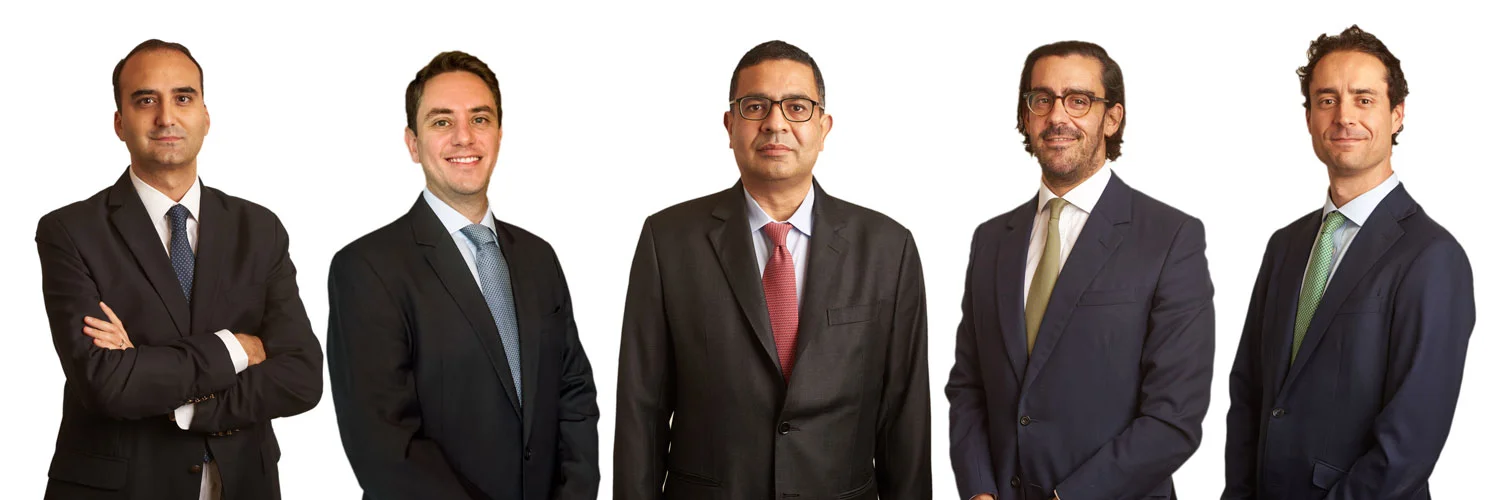
Risk solutions house of the year: Santander
Risk Awards 2021: agile approach kept complex transactions on track during pandemic

Santander Corporate & Investment Banking was juggling a startling array of large, complex transactions when the Covid-19 pandemic tore through markets in March. The bank needed to purchase 600 million reais ($120 million) of shares in Brazilian agribusiness conglomerate Cosan to hedge an equity swap with its offshore parent company. A $10 billion gas pipeline investment and the sale of hundreds of buses bound for Bogota also hung in the balance.
The quick thinking and resourcefulness of Santander’s risk solutions team kept the deals on track. “The landscape changed quickly and being nimble and having a flat structure enables us to turn things around quickly to meet challenging deadlines for clients,” says Krishna Murali, Santander’s global head of sales.
The Cosan transaction went ahead after Santander agreed to increase the firm’s share of any hedging profits from 50% to 70% to offset a 50 basis point increase in the swap price. Amid whipsawing foreign exchange markets, the bank provided Transmilenio, the operator of Bogotá’s bus rapid-transit system, a lifeline of FX forwards to pre-hedge any currency depreciation, which would have increased the dollar-denominated cost of its new vehicles. A deal contingent forward-starting interest swap got the gas pipeline acquisition over the line.
In each case, the bank left no stone unturned in its search for solutions. “We’ve not only been there for our clients on the financing side, but also on the risk management side and in markets, where we’ve looked at clients’ existing portfolios to see how we can help them in terms of generating some liquidity from existing positions,” says Murali.
This agile approach also earns Santander plenty of praise from clients. “They have been one of the few go-to-firms when you need things done quickly and with pragmatism,” says an investor in a recent transaction led by the Spanish bank. “They can go past layers of bureaucracy and make decisions quickly.”
Cosan’s corporate restructuring
Santander has long punched above its weight in infrastructure, project finance and renewables. In 2020, the bank leaned into its local Latin American presence, where the ability to book transactions in Spain, which has favourable tax treaties with much of the region, gives it an edge over rivals.
“In Latin America, there are a lot of players that can offer cross-border solutions and at the same time a lot of banks that can only offer onshore solutions. We can offer both and it’s the client’s choice as to what can optimise their position,” says Juan Saffon, Santander’s head of rates, Europe.
“As an international bank with local presence we have the best of both worlds in countries like Brazil, where the onshore pricing is different from the offshore pricing. By making sure clients understand the dynamics, they can choose the right entry point and get the best solution at the time of implementing.”
In Brazil, a dramatic plunge in rates from 14% to 2% in just two years set the stage for the bank to expand its operations there, first in commodities and, more recently, equities.
In 2020, Santander was approached by Cosan to provide a five-year equity swap, which would grant its Bermuda-based holding company equity economics and voting rights in its onshore businesses.
In Latin America, there are a lot of players that can offer cross-border solutions and at the same time a lot of banks that can only offer onshore solutions. We can offer both and it’s the client’s choice as to what can optimise their position
Juan Saffon, Santander
The transaction came with a health warning as over-the-counter derivatives between onshore and offshore counterparties are subject to punitive tax treatment in Brazil. Santander had to navigate a labyrinth of tax and regulatory concerns, as well as complex collateral and stock lending arrangements to make the deal work.
The bank opted for a tried-and-tested chain of back-to-back transactions. Santander Brazil entered into a total return swap with an onshore fund holding shares of Cosan. This fund entered into another swap with a second Brazil-based fund, which holds an interest in an offshore fund. The offshore fund entered into a total return swap with an offshore branch of Santander, which dealt directly with Cosan’s offshore parent company.
To hedge the swap exposure, Santander had to purchase around six times the daily average volume of Cosan shares. The transactions were spread out over two months and the average purchase price came in below the swap level. The lion’s share of the hedging profits was returned to the client after the bank agreed to a 70/30 split in a revised, post-Covid term sheet.
“The market saw huge volatility but we managed to execute the transaction in a very smooth way, providing the client not only with a way of acquiring the shares without using its own funds, but with a good price, and in the end, some benefit on the final share price,” says Rafael Kappaz, head of markets sales at Santander Brazil.
A standard collateral agreement was out of the question for an offshore shell company living on dividends. Under a bespoke package, Santander received an independent amount equivalent to 30% (180 million reais) of the swap notional in Cosan shares, plus another 20% (120 million reais) in shares of Cosan Logistica – another of the group’s listed entities – as initial margin to cover mark-to-market moves on a weekly basis. An additional credit support annex provides for more Cosan Logistica stock to be posted as variation margin, subject to a 50% threshold in mark-to-market moves. The structure ensures the holding company would only deposit cash collateral following a 65% depreciation in the shares.
The client was impressed with the Santander’s efforts. “They built and delivered a product that wasn’t available on the shelf of any other house,” says Cosan treasurer Adriano Ortega Carvalho. “To build it up, we had points that were important for us, and they had their points, but both sides always understood what was a dealbreaker, and the discussions were very productive.”
On the buses
Bogotá’s 114-kilometer bus rapid-transit system, TransMilenio, is used by 2.5 million of the city’s 8 million residents each day. But overcrowding and heavily polluting vehicles were becoming a perennial source of complaints among commuters. A 1,400-strong fleet upgrade aims to increase capacity and slash emissions by 95%.
Santander agreed to provide $262 million of synthetic local currency loans with export credit agency (ECA) backing to finance the purchase of 440 “euro V” class diesel busses from Volvo and 741 “euro VI” gas-powered vehicles manufactured by Scania.
The deal, spread over four separate transactions, called for deep expertise in trade finance, capital controls, foreign exchange, derivatives and local legal frameworks.
“These processes are long because you need to make sure that all of the parties find common ground. Being able to communicate in the client’s language and in the ECA’s language on very complex concepts such as the embedded derivative was probably what gave them enough confidence to land that transaction,” says Saffon.
“It helped that we were not wedded to any single solution. So many other banks that we’re competing with wanted to offer a single vertical, but we come to a client with the spectrum of solutions and then work with them to see what suits them the best.”
As a condition of the public tender, TransMilenio needed vehicle loans in Colombian pesos – a non-deliverable currency. Scania required a structure which did not expose them to residual credit or FX risk.
It was very clear when the crisis started and [the Colombian peso] went from 3,300 [versus the US dollar] to 4,150 and back to 3,500 again, that the pre-hedging we were offering and the swift execution of the synthetic loan were key
Matias Mayora, Santander
Santander created a facility with dollar funding from its own Treasury and sourced Colombian pesos via cross-currency swaps. This allowed the bank to offer synthetic 10-year amortising peso loans, backed by Sweden’s export credit agency, EKN, at a better rate than local market alternatives. It also ensured Scania could be paid in US dollars.
The final transaction – a $40 million-equivalent loan covering 130 Scania buses – hit unfortunate timing. Funding spreads for Santander and the Swedish quasi-sovereign were little changed immediately after the Covid market meltdown, but bid-offer spreads on long-dated cross-currency swaps surged from around 10bp to as much as 50bp.
“We needed to underwrite the risk at exactly the right moment, but fortunately we could always find liquidity to execute,” says Matias Mayora, head of private side structuring for Europe at Santander. “This is a complex deal as it requires a lot of co-ordination, but we were able to disperse very quickly in the middle of a crisis because of all the experience of three deals before.”
To reduce market impact and minimise transaction costs, the bank executed the swaps in smaller clips. Additional FX pre-hedging meant the deal could complete without any price widening.
“Under normal circumstances borrowers tend to be reluctant to pre-hedge because the currency is pretty stable and the interest rate differential would mean a negative carry, but it was very clear when the crisis started and [the Colombian peso] went from 3,300 [versus the US dollar] to 4,150 and back to 3,500 again, that the pre-hedging we were offering and the swift execution of the synthetic loan were key,” Mayora says.
Finding financing for this type of deal is not always easy and lenders have been scorched by poorly designed structures in the past, says Juan Carlo Ocampo, general manager for Scania’s Colombia operations.
“It took a long time to convince lenders what’s different this time, but this is a very well-designed project and Santander realised that. They were very pragmatic and understood things from the very beginning, developing a product that fits with the cashflow,” says Ocampo.
He adds that all stakeholders – customers, suppliers, banks and authorities – were aligned in a common vision. “Without that, this wouldn´t be possible.”
Ocampo hopes to replicate the structure for future deals in Colombia or other emerging markets where the manufacturer has a presence.
Infra-galactic
In recent years, Santander has carved a niche for itself in financing large infrastructure projects. In 2020, the bank pulled out all the stops to close one of its biggest deals to date – the acquisition of a $10 billion minority stake in gas pipelines run by Abu Dhabi National Oil Company.
The “Galaxy” consortium of six infrastructure funds, led by GIP and Brookfield, took a 20-year lease in the asset. At $8 billion, the financing needed was outsize for an immediate trip to the capital markets. Instead the group took a three-year bridge facility, ultimately syndicated to 17 banks, and sought hedges for its best estimate of the future steady state capital structure.
One of three hedging co-ordinators, Santander provided vanilla interest rate swaps to cover the long-term market risk. The bank also led a pre-hedge for the expected bond market take-out via a deal contingent forward-starting interest rate swap – a first for the sponsor group.
The benefits of this pre-hedge were twofold, according to Christian Banna, head of UK corporate sales. As well as reducing the risk of the sponsors being forced to settle the mark-to-market in the event a bond deal could not be completed, it also helped speed a transaction with multiple stakeholders on a particularly bumpy road.
Our risk management proposition for clients is always part of a bigger picture and our deal contingent capability enhances this, but it’s part of the broader delivery of the whole transaction which typically includes a financing underwrite role
Christian Banna, Santander
“Even with the common objective of mitigating the market risk as early as possible, where you have multiple sponsors in a consortium trying to complete such a transaction, things can take time,” says Banna. “While viable alternatives exist for hedging in advance of owning an asset, paying for optionality, providing guarantees or collateral though bilateral agreements is time consuming. Structuring the hedge in deal contingent format therefore provided the most feasible solution with the added benefit of the hedge providers underwriting the M&A completion risk at competitive levels.”
In October, Galaxy took out half of the facility with the issue of $4 billion in amortising notes.
While deal contingent business has become highly commoditised, premiums have increased alongside rising volatility, mounting trade and anti-trust concerns. Some banks have stepped away in response to the increased risk of deal failure. Santander is also cautious, but remained confident given its front-to-back involvement in the transaction.
“Our risk management proposition for clients is always part of a bigger picture and our deal contingent capability enhances this, but it’s part of the broader delivery of the whole transaction which typically includes a financing underwrite role,” says Banna. “We’re not just looking to do a DC hedge for the sake of it, we’re always looking to sit down with sponsors from the very beginning when they’re looking at acquiring an asset to help them assess the risks and come up with the best solution to take risk off the table.”
Plymouth docks
Other deals grew out of the turmoil in markets. But that doesn’t mean the path to execution was easy.
Interest rate swaps have been out of reach for UK local authorities since 1989, when a court voided part of a crippling £4 billion ($5.5 billion) swaps bet held by Hammersmith and Fulham council.
The UK’s 2011 Localism Act opened the door for a revival – at least in theory. For many dealers, sour memories of battered reputations and an estimated £600 million in losses loom large.
When Plymouth County Council spied an opportunity to lock in historically low rates, Santander was well placed, having escaped the brunt of past mis-selling scandals.
In April, the ring-fenced UK bank entered into a £75 million 20-year interest rate swap with the authority. In a nod to Libor’s planned demise, the swap references the sterling overnight index average. Although it creates a basis risk to the short-term variable loans the swap will hedge, the client was comfortable given the 2% improvement on intra-authority financing rates.
Despite coming shortly after Covid sapped liquidity in rates markets, timing proved fortuitous. Between March 10 and March 20, Sonia fell from 70bp to just 0.7bp as the Bank of England slashed base rates in response to the crisis. But far from knee-jerk opportunism, the deal was four years in the making. Extensive groundwork – including legal opinions for both sides – and due diligence around governance and appropriateness aimed to ensure the ghosts of past scandals remain firmly buried.
“It’s that level of due diligence that gave us the confidence to lead the charge,” says Stuart Selby-Jerrold, of Santander’s risk solutions group. “It’s not for everybody. It has very much got to be considered as part of the overall financing strategy but there will be a place for it to be used by other local authorities in the future.”
Only users who have a paid subscription or are part of a corporate subscription are able to print or copy content.
To access these options, along with all other subscription benefits, please contact info@risk.net or view our subscription options here: http://subscriptions.risk.net/subscribe
You are currently unable to print this content. Please contact info@risk.net to find out more.
You are currently unable to copy this content. Please contact info@risk.net to find out more.
Copyright Infopro Digital Limited. All rights reserved.
As outlined in our terms and conditions, https://www.infopro-digital.com/terms-and-conditions/subscriptions/ (point 2.4), printing is limited to a single copy.
If you would like to purchase additional rights please email info@risk.net
Copyright Infopro Digital Limited. All rights reserved.
You may share this content using our article tools. As outlined in our terms and conditions, https://www.infopro-digital.com/terms-and-conditions/subscriptions/ (clause 2.4), an Authorised User may only make one copy of the materials for their own personal use. You must also comply with the restrictions in clause 2.5.
If you would like to purchase additional rights please email info@risk.net
More on Awards
Trading systems: structured products/cross-asset – Murex
Murex won the Trading systems: structured products/cross-asset award at the 2025 Risk Markets Technology Awards for its MX.3 platform, praised for its flexibility and advanced analytics
Best vendor for system support and implementation: Murex
Murex has won the Best vendor for system support and implementation at the Risk Markets Technology Awards, recognised for its innovative MX.3 platform, exceptional client support and seamless implementation services
FRTB-IMA product of the year: Murex
Murex wins FRTB-IMA product of the year for its advanced, scalable MX.3 platform enabling seamless regulatory compliance
Pricing and analytics: equities – Finastra
Finastra’s Sophis platform wins the Risk Markets Technology Award for Pricing and analytics in equities, recognised for its robust capabilities in equities and derivatives trading
Best execution product of the year: Tradefeedr
Tradefeedr won Best execution product of the year for its API platform, which standardises and streamlines FX trading data, enabling better performance analysis and collaboration across financial institutions
Collateral management and optimisation product of the year: LSEG Post Trade
LSEG Post Trade wins Collateral management and optimisation product of the year for interconnected services that help mitigate counterparty risk and optimise capital usage
Clearing house of the year: LCH
Risk Awards 2025: LCH outshines rivals in its commitment to innovation and co-operation with clearing members
Driving innovation in risk management and technology
ActiveViam secured three major wins at the Risk Markets Technology Awards 2025 through its commitment to innovation in risk management and technology







